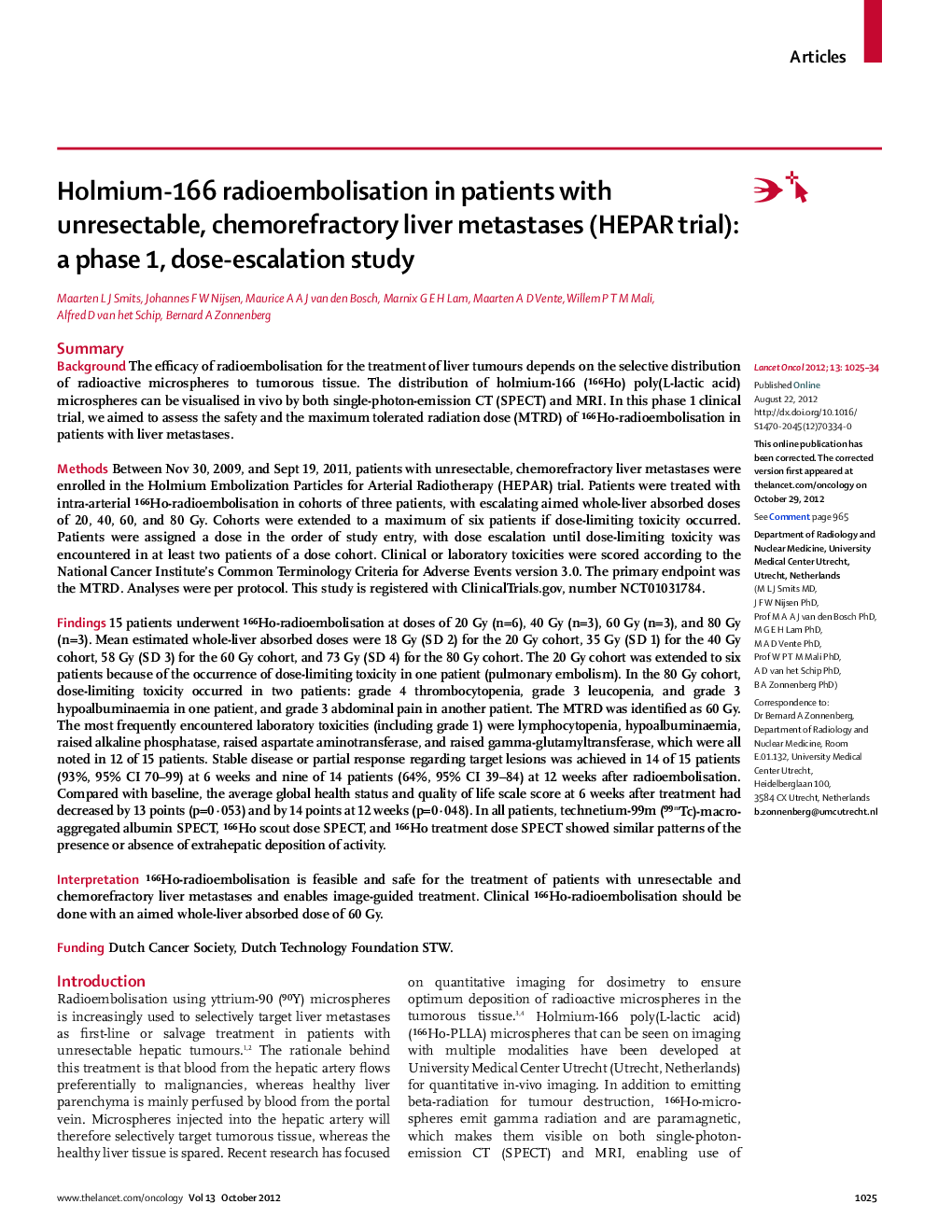| Article ID | Journal | Published Year | Pages | File Type |
|---|---|---|---|---|
| 3994101 | The Lancet Oncology | 2012 | 10 Pages |
SummaryBackgroundThe efficacy of radioembolisation for the treatment of liver tumours depends on the selective distribution of radioactive microspheres to tumorous tissue. The distribution of holmium-166 (166Ho) poly(L-lactic acid) microspheres can be visualised in vivo by both single-photon-emission CT (SPECT) and MRI. In this phase 1 clinical trial, we aimed to assess the safety and the maximum tolerated radiation dose (MTRD) of 166Ho-radioembolisation in patients with liver metastases.MethodsBetween Nov 30, 2009, and Sept 19, 2011, patients with unresectable, chemorefractory liver metastases were enrolled in the Holmium Embolization Particles for Arterial Radiotherapy (HEPAR) trial. Patients were treated with intra-arterial 166Ho-radioembolisation in cohorts of three patients, with escalating aimed whole-liver absorbed doses of 20, 40, 60, and 80 Gy. Cohorts were extended to a maximum of six patients if dose-limiting toxicity occurred. Patients were assigned a dose in the order of study entry, with dose escalation until dose-limiting toxicity was encountered in at least two patients of a dose cohort. Clinical or laboratory toxicities were scored according to the National Cancer Institute's Common Terminology Criteria for Adverse Events version 3.0. The primary endpoint was the MTRD. Analyses were per protocol. This study is registered with ClinicalTrials.gov, number NCT01031784.Findings15 patients underwent 166Ho-radioembolisation at doses of 20 Gy (n=6), 40 Gy (n=3), 60 Gy (n=3), and 80 Gy (n=3). Mean estimated whole-liver absorbed doses were 18 Gy (SD 2) for the 20 Gy cohort, 35 Gy (SD 1) for the 40 Gy cohort, 58 Gy (SD 3) for the 60 Gy cohort, and 73 Gy (SD 4) for the 80 Gy cohort. The 20 Gy cohort was extended to six patients because of the occurrence of dose-limiting toxicity in one patient (pulmonary embolism). In the 80 Gy cohort, dose-limiting toxicity occurred in two patients: grade 4 thrombocytopenia, grade 3 leucopenia, and grade 3 hypoalbuminaemia in one patient, and grade 3 abdominal pain in another patient. The MTRD was identified as 60 Gy. The most frequently encountered laboratory toxicities (including grade 1) were lymphocytopenia, hypoalbuminaemia, raised alkaline phosphatase, raised aspartate aminotransferase, and raised gamma-glutamyltransferase, which were all noted in 12 of 15 patients. Stable disease or partial response regarding target lesions was achieved in 14 of 15 patients (93%, 95% CI 70–99) at 6 weeks and nine of 14 patients (64%, 95% CI 39–84) at 12 weeks after radioembolisation. Compared with baseline, the average global health status and quality of life scale score at 6 weeks after treatment had decreased by 13 points (p=0·053) and by 14 points at 12 weeks (p=0·048). In all patients, technetium-99m (99mTc)-macro-aggregated albumin SPECT, 166Ho scout dose SPECT, and 166Ho treatment dose SPECT showed similar patterns of the presence or absence of extrahepatic deposition of activity.Interpretation166Ho-radioembolisation is feasible and safe for the treatment of patients with unresectable and chemorefractory liver metastases and enables image-guided treatment. Clinical 166Ho-radioembolisation should be done with an aimed whole-liver absorbed dose of 60 Gy.FundingDutch Cancer Society, Dutch Technology Foundation STW.
